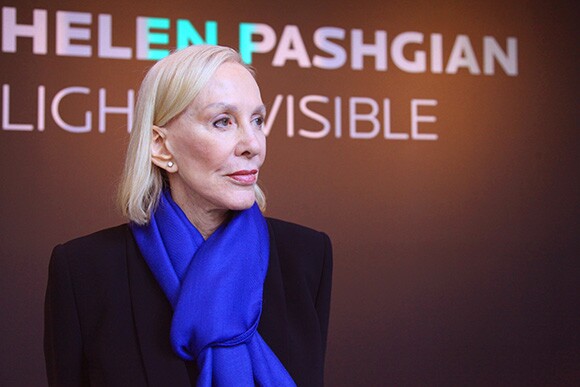Helen Pashgian Considers Light and Its Absence
On March 30, Los Angeles County Museum of Art debuts a new sculptural piece by Helen Pashgian, whose works exist on the continuum of Light and Space art movement of Southern California. Yet to simply call Pashgian's new work a sculpture doesn't quite do it justice. "Light Invisible" is an experiential space: 12 two-part acrylic columns bisect a darkened room, illumined by light above, which diffuses a soft glow throughout. The lights slowly fade up and down, somewhat resembling a time-lapse video of the day turning into night and back again, never filling the room entirely with light, instead leaving an inky darkness around the periphery of the space. The works draw attention to light and its absence, providing experience perhaps akin to wading through the dark matter between stars.

Pashgian was born in Pasadena in 1934. In the 1960s, she worked with new materials that were being developed in the nearby aeronautics and automotive industries. Plastics, fiberglass, and polyester resin were distinct new materials that were entirely 20th century creations, and Pashgian - and the other artists of the Light and Space movement - made artwork that was impossible just a few years prior. "The process is top secret," she told me while we sat nearby her columns. Her works, like the works of James Turrell -- also exhibited at LACMA -- focused on light itself and the affect (and effect) it has on its viewers.
By its very title, "Light Invisible," the piece seems to suggest that light itself is all around us, but somehow remains hidden in plain sight. We swim in light. Life feeds on it. Our bodies ingest it, our emotions are tied to it as well. Pashgian's 12 glowing objects -- like the 12 hours of on the clock -- perhaps implores spectators to ruminate on the nature of time too. Time is a human construction, based on the alternation of light and darkness, and when walking past the row of pillars, viewers experience a similar series of intervals.
The interaction between the columns and spectators is nearly universal, people want to be close to the radiating objects, slowly walking closer like moths to incandescent porch light. Then in close proximity to the works, another effect occurs, the negative space of the room -- that murky darkness -- becomes alluring as well. If viewers look way from sculptures and instead consider the objects as light sources, the faces of observers gazing at them are illuminated as well. With the pitch black as a backdrop, the lit-up faces of the spectators appear to be portraits, much like the chiaroscuro-drenched paintings lining the walls of Victorian salons or darkened basement bars. The audience becomes the art, or part of the installation. As bodies walking close to the pillars become visible by the light, then invisible in the black as they walk away, the piece seems to ruminate on memory and its decay; those people who enter and exit your own life.
Time in Pashgian's microcosm is obliterated. But when the time comes to leave the installation, one is plunged back into the Southern California sun, blinded by the daylight.


Dig this story? Sign up for our newsletter to get unique arts & culture stories and videos from across Southern California in your inbox. Also, follow Artbound on Facebook and Twitter.